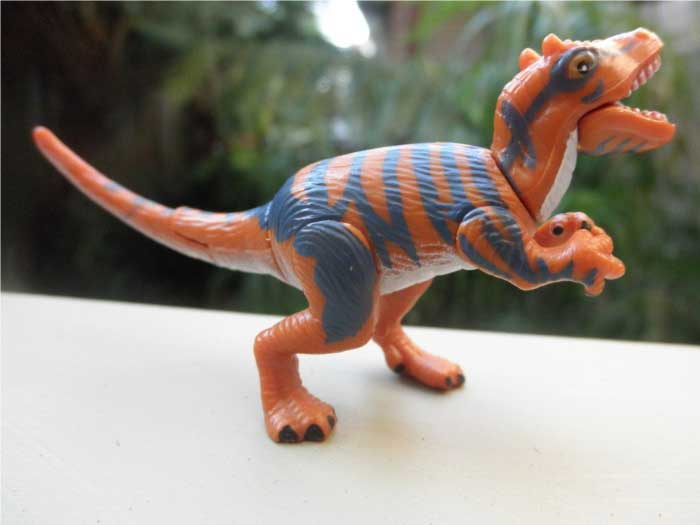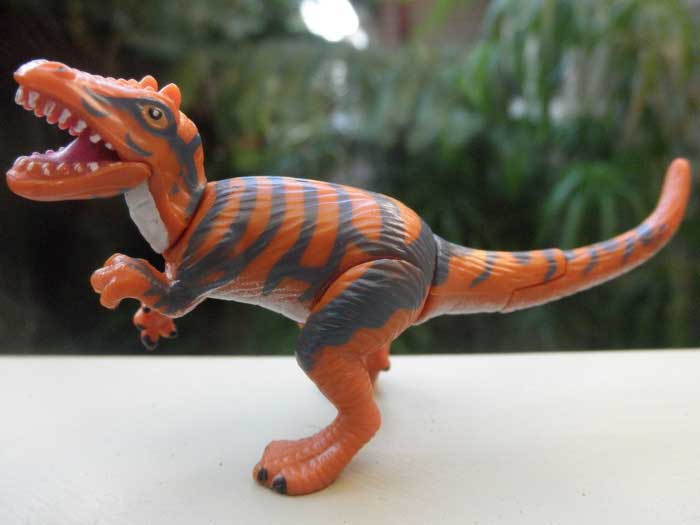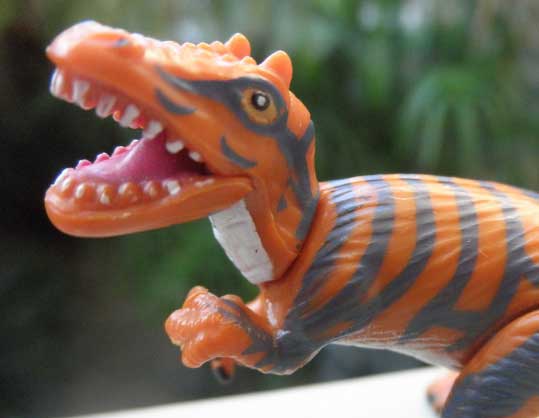Review and photos by Brontozaurus, edited by Plesiosauria.
The existence of an Australian allosaurid is based on an ankle bone discovered in the sea cliffs of Cape Paterson in south-eastern Australia, near the famous Dinosaur Cove site. This bone was referred to the genus Allosaurus; if it really is a species of Allosaurus then it’s not only a small species (estimated to have been around 6 metres in length), but it’s also a very late surviving species, as it came from Early Cretaceous rocks, whereas other Allosaurus species were from the Jurassic. It’s possibly because of this connection to a more famous dinosaur that the Australian allosaurid was the most prominent Australian theropod until Australovenator was discovered. The allosaur made its way into scientific books, children’s literature, documentaries (including a role in Walking with Dinosaurs) and toys. It was included as part of the first series of Lost Kingdoms Yowies, and it was one of those that my friends and I (who collected them like mad) designated as being one of the rarest figures in the line, an honour shared with the Queensland Pterosaur and the Marsupial Lion), at least, that this fierce carnivore never showed up in our Yowies. I never got one until now, over ten years later.

It’s one of the larger figures in the line, being 9cm in length and about 5cm high. It’s also one of the most elaborately patterned Yowie dinosaurs, featuring a pattern of blue stripes over an orange base colour, with a white underside. This is hardly a realistic colour scheme, though it should be noted that realistic colour schemes are something that a lot of yowies aren’t known for (see, for example, the banana-yellow Kronosaurus). However, the colours work together well and make the allosaur interesting to look at. Like most yowies, the
allosaur can move slightly. While most yowies achieve this via interlocking mechanisms, the allosaur’s movement is derived from rotating joints. The head, tail, and right arm can all rotate. The legs can also move, though they are moulded to fit the body and so they aren’t really meant to be moved.

There’s some good sculpted detail on the allosaur, as is common with Yowie figures. There are skin wrinkles on the body and scales on the hands and toes. The teeth are individually picked out, and the horns on the head run down the snout in a line. However, it is with these horns that we encounter the first inaccuracy of this model. Allosaurid dinosaurs had the horns in front of the eyes, whereas on this model the horns are directly above the eyes, like in dinosaurs such as Carnotaurus. Furthermore, this model has four fingers on each hand, but allosaurids had lost the fourth finger entirely. As this model is meant to be a generic allosaurid, though, you could think of it more as a weird Australian form, particularly as it might be closer to Australovenator than Allosaurus.

While I’m fond of this figure, I’m not sure if I can really recommend the Australian allosaurid to most people. Yowie collectors will probably want this figure, but for everyone else I’m not so sure. It’s been out of production for over ten years, it’s hard to find, and it’s a generic allosaurid rather than a specific species. In a world where the Papo Allosaurus exists and is easier to obtain, you’re better off with one of those than this little model. But if you so want to track one down, sites like eBay or the Australian Quicksales website (where I got mine from) are your best bets for unearthing an Australian allosaurid.
Disclaimer: links to Ebay and Amazon on the DinoToyBlog are affiliate links, so we make a small commission if you use them. Thanks for supporting us!




The ankle bone that inspired this was actually re-analyzed a few years ago and found to be more similar to Fukuiraptor than anything else.
Then Australovenator was discovered and was shown to be the sister taxon to Fukuiraptor. So the most likely scenario in my opinion is that the bone belonged to Australovenator.
being the luckly little brat i was i managed to get one of these as a kid. i still have it along with the rest of the complete set of yowies in an ice cream tub under my bed
It looks almost…feathery. I wonder if that was intentional?
I was going to say just that, but didn’t want to be thought of as having feathers on the brain, in light of recent posts!
It’s very much debatable. The official collector’s guide that came out with this series mentions that the allosaur may have had fur or feathers to deal with the cold climate, but the dromaeosaur from the same series (and the same location as the allosaur) is naked, and the artwork on the allosaur’s leaflet doesn’t show feathers either.